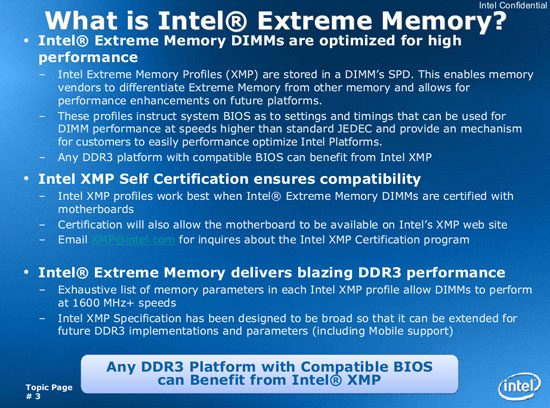Intel, along with Kingston and Asus held a web cast yesterday to better explain a new concept called XMP, which simply stands for Extreme Memory Profiles. The technology is designed to give the new and amateur overclocker the confidence that is needed to properly overclock his computer with compatible hardware that will guarantee a certain level of overclocking with DDR3 modules that are XMP compatible. It also allows the enthusiast the opportunity to fine tune things even more and set their DDR3 modules to automatically start up a system in an overclocked state using one of two profiles that are available in the SPD of the modules. Let’s take a closer look…

As you can see from the slide, the profiles for the overclocked DDR3 modules are stored in the SPD of the DIMM. As the computer boots, the BIOS detects the program in the SPD and automatically adjusts settings to overclock the DDR3 modules, as well as other settings that may need to be adjusted, such as the FSB, vdimm and vcore among other settings. It also allows for the timings on your DDR3 modules to be adjusted as needed. Let's take a more detailed look at this.

These screens give you a little better picture of what happens as the computer boots. It is able to start at JEDEC defined standards to ensure compatibility. You also have the option to boot at parameters that are specified in the XMP profile space in the SPD of the modules. This is activated by a setting in the BIOS, or through a setup utility. The modules that come with the XMP certification will be guaranteed to run at speeds that are well above the JEDEC standards. This is accomplished by pairing the XMP DDR3 modules with other hardware that is also XMP certified.

Each DIMM manufacturer will be responsible to self-certify its parts with motherboard manufacturers and will be responsible to provide the results to Intel, who will then post an XMP compatibility chart on its website, so that the end user can have confidence that the parts that he is choosing will be a perfect fit, and give him the best chance at a maximum overclock of his system. Intel says that it will periodically perform audits on the parts to make sure that quality and compatibility are maintained.
With the announcement of this technology, Kingston and ASUS both revealed parts that either are or soon will be XMP certified.

Kingston currently has its DDR3-1625 part that is XMP certified, and will soon be releasing an 1800mhz part.

ASUS also showed off the very first motherboard to support XMP in that the P5E3 Deluxe WiFi. ASUS also said that XMP will be a part of all of their future high end series of boards.
Conclusion:
XMP basically does three things:
- It ensures compatibility between DDR3 modules and the motherboards they will be working in.
- It allows the novice or new overclocker to have some security in their new venture into overclocking by providing a certain level of guaranteed success.
- It allows the enthusiast to be able to set their DDR3 modules to a confirmed setting that the can easily and quickly switch to for maximum performance at any given time.
































